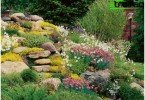Assortment of perennial flowers for the design of flower beds
Practical gardeners who do not want to bother every season with planting seeds and picking seedlings focus on perennials for flower beds. These plants require attention only the first year, until they take root. Then, when they enter full force, they begin to bloom profusely or delight with decorative leaves. And some are planted themselves, so intense that you have to share the seedlings with the neighbors in the site. Let’s consider how to choose perennial flowers for the design of flower beds, with what to combine and where to plant.
Content
- The main groups of perennials
- Unpretentious flowers for flower beds: we study plants with original foliage
- The most beautiful perennials: we select plants with large inflorescences
- Low-growing flowers for the garden: perennial plants with a long flowering period
The main groups of perennials
There are a lot of plants that can live in one place for a long time, so flower growers conditionally divided them into several groups:
- According to the characteristics of the root system: tuberous, bulbous and rhizome.
- By decoration: with beautiful leaves, with large flowers, blooming all summer.
- By the features of care: requiring excavation or shelter for the winter and not requiring.
For flower beds, they select not only perennial flowers that bloom all summer, but also a background addition to them – plants that have a very spectacular aerial part (leaves, stems, etc.). Against the background of dense green vegetation, lush inflorescences look even brighter and more spectacular.
Unpretentious flowers for flower beds: we study plants with original foliage
The design of flower beds is best to start with the most unpretentious plants that are good not so much in bloom as in the increased decorativeness of the bush. They retain a wonderful appearance until winter, until the first frost sets in. About such plants they also say “planted and forgot”, because they require minimal care. It is enough to place the roots in a healthy soil, provide the desired level of moisture – and your site will shine with spectacular green spots of vegetation by the next spring. The best perennial garden flowers: photos and features of care:
- Hosts
A great option for partial shady places. Massive succulent leaves create a beautiful rosette of a semicircular shape, in the center of which by June high stalks with small flowers shoot. The host is appreciated for the variety of leaf texture. Not only that, more than 70 varieties were created with different colors (from dark green to yellow, with a white edging and bluish veins, etc.), the sheet surface itself is also matte, glossy, pimpled, with embossed stripes, etc. A mono-flower from one host is an excellent sight!
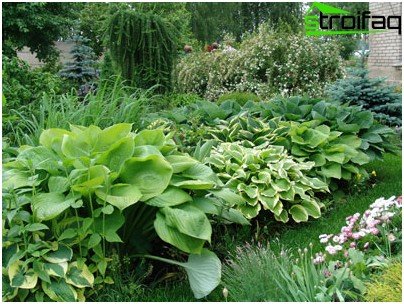
Hosts are so self-contained and decorative that they can decorate any zone even without involving other perennials
- Astilbe
You can call the host “friends” because they also love partial shade. True, their root system is weaker than that of the hosts, and requires frequent recharge of moisture. Only in this case, the plants will give a lush bush with small patterned leaves, and from July to August they will be pleased with unusual panicle inflorescences..

During the flowering period, it is crowned with a luxurious hat of panicle fluffy inflorescences.
- Astilboides
The same astilbe is heard in the name of the plant, but in reality it is a completely different perennial. It has rounded leaves with a patterned edge that cover the basal rosette, like a bunch of umbrellas. They always plant in the center of the flowerbed, because every year the plant increases its height. Up to 3 years – it is kept in the region of a meter, and closer to ten leaves are tipped out above 1.5 meters. To grow such beauty, buy seeds of perennial flowers or divide the bush into several parts, chopping rhizomes. Like many large foliage plants, astilboides prefers partial shade and moist places..
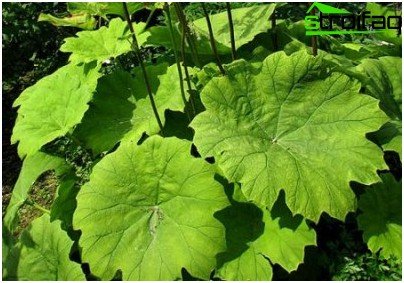
Huge cut-out leaves of astilboides require a lot of free space
- Stonecrop
A characteristic feature of these plants is a clear, compact form of the bush. All leaves come from almost one point and form a beautiful ball that looks powerful due to fleshy stems and leaves. By autumn, each stem at the end is covered with pinkish inflorescences, without losing the decorative foliage. Stonecrop is not “friends” with previous plants, because it loves the sun. In the shade, its stems may lie. But it is absolutely not picky about the soil and grows well on sandy soil.
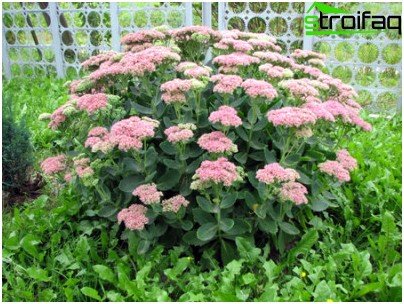
If you put a young stonecrop in a concrete decorative ring, it will always keep a compact shape
- Badanas
They are distinguished by powerful leathery leaves, which closer to autumn acquire a bronze or reddish hue. Bloom in May for about 4 weeks, but may not produce flower stalks at all if planted in a shady place. But there the incense will build a beautiful green mass, even on poor ground. For the peculiar shape of the leaves received the nickname “elephant ears.” Under natural conditions, the lower leaves of a canoe gradually lag behind the outlet, covering the ground with a carpet that protects the soil from drying out. On a flower bed, dry leaves will not look very aesthetically pleasing, so they are removed, but the earth is mulched.
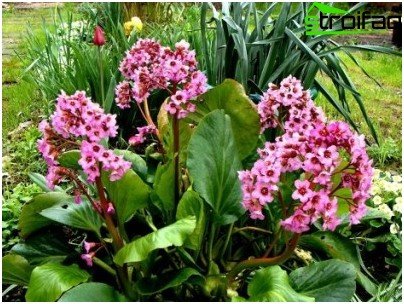
Badan does not tolerate dry places, because massive leaves evaporate moisture too quickly
The most beautiful perennials: we select plants with large inflorescences
When the green background is created, you need to make bright color spots. For this, tall varieties of perennial flowers, distinguished by large inflorescences, are suitable. They can land as soloists, breaking the monotony of the lawn, or be in the center of multi-tiered flower beds. If you study the selection of photos of perennial flowers on the network, you can distinguish the four most popular plants. The first place is roses. No plant can compete with a rose in beauty; it is not for nothing that these perennial flowers appear more often than others in the photo. When the flowering season begins, the bush seems to be drenched with colorful, large and fragrant inflorescences, visible from afar. Depending on the variety, roses can bloom once, twice a season and throughout the summer. The most simple to care for are climbing varieties. They are able to increase the whips to 3 meters per season and please gorgeous flowering. True, only a month and a half. But most varieties tolerate winter without shelter. If you want a rose that will bloom again in the fall, then you should look for a hybrid tea variety. And for constant flowering, floribundas are suitable, which grow up to a meter, but they do not release flowers all at once, but gradually.
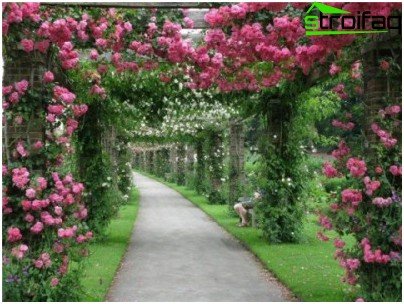
Roses are good in solitary plantings, especially climbing varieties that reach 2-3 m in height.
Second place is Cannes. These flowers are conventionally divided into two types: with large tall leaves, but small peduncles and vice versa. It all depends on the variety. The advantage of Cannes is that you can forget about them in general until the fall. Not a single weed is able to break through a dense veil of leathery leaves, and they are extinct to 2 meters. Low-growing varieties are distinguished by luxurious large inflorescences in red, orange, yellow tones. It is after them that the people go in early spring to the nursery of perennial flowers. Kanna begins to bloom in early summer and does not stop until frost. The only negative – it needs to be dug for the winter, otherwise it will freeze.
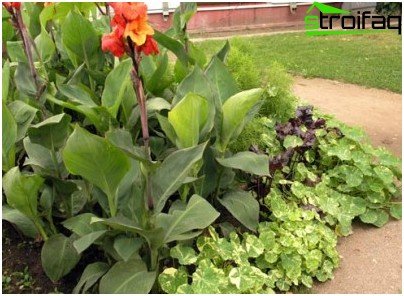
Cannes are practically not affected by diseases, but they can’t stand the cold winters in the ground
Third place – chrysanthemums. These perennial unpretentious flowers rule the ball in the fall, because they bloom at this time. But already from spring, their aerial part with fluffy leaves is very decorative, so it can serve as a backdrop for early flowering bulbous. Chrysanthemums grow in any soil, but can respond to changes in illumination by weak flowering. They are not recommended to be planted near night lights, so as not to knock off the life cycle. Such perennial flowers from seeds to grow for a long time, so the housewives try to buy a finished bush and gradually divide it into parts.
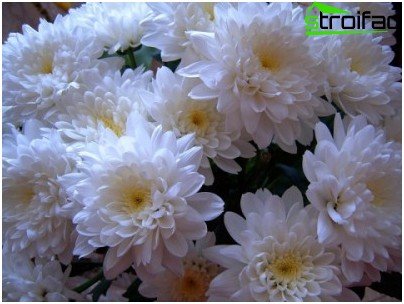
It’s more convenient to buy chrysanthemums with a bush in a pot, because they will bloom this season
Fourth place – irises. If you look into the catalog of perennial flowers, then the iris in it will occupy at least 3 pages. A huge number of chic varieties have been created that are not afraid of either drought or frost, wintering without shelter. Most irises are up to 50-70 cm tall, although peduncles are more than a meter long. The leaves are narrow, long, arranged in a circle near the basal rosette. Both autumn planting of perennial flowers and early spring are allowed. This flower in a couple of years becomes such a powerful bush that it requires division, otherwise flowering may worsen.
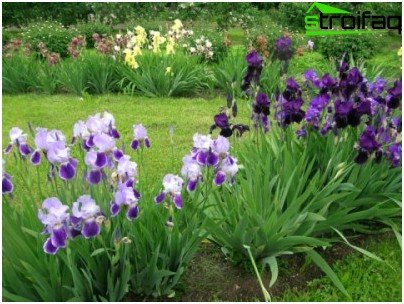
Irises are good both in monopods and in combination with lower plants.
Low-growing flowers for the garden: perennial plants with a long flowering period
To frame the edges of the tracks, create a lively border, use undersized perennial flowers. They cover the ground with a continuous carpet, strewn with a scattering of small flowers, and fill the lower tiers of flower beds. If you need to fill the gaps between the stones in the alpine hill, then pay attention to the yapolka. It creates such a dense hat that all weeds die. True, the first year will have to suffer from sowing seeds, because seedlings of perennial flowers of this variety are extremely rare on sale. The yapolka is sown at about the same time as petunias and kept on window sills until June, when the threat of frost passes. Next summer at the end of May your hill will be covered with incredibly beautiful and dense flowers that will bloom for about a month.
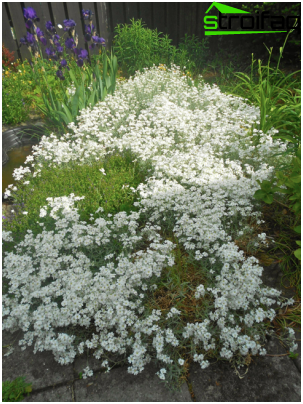
Lamb is perfectly divided by roots, but this method of reproduction can be used only for overgrown bushes
Perennial bulbous flowers are also suitable for the lower tier, because most of them have a height of no more than 40 cm. Of course, it is more profitable to use varieties that do not require digging for the winter – daffodils, poultry farmers, anemones, tulips, lilies. Some summer residents plant summer perennial indoor flowers – geraniums and begonias – in flower beds in summer. But here the correct selection of place and lighting is required, because after the greenhouse conditions of the apartment the plants will have a period of acclimatization.



